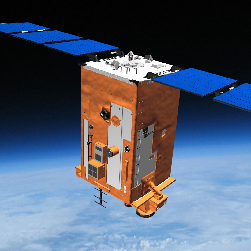Scientists of Samara University have created a set of scientific equipment that will help to make space exploration more accessible. It is called “Particle Sensor ДЧ-01” and is set on board a spacecraft “Aist-2D”, created by the University scientists and experts of the Rocket and Space Centre “Progress”. In late April ДЧ-01 will go into space together with “Aist-2D” from the new Russian space launcher complex Vostochniy during the first launch campaign.
“Particle Sensor ДЧ-01” is an on-board mini-laboratory for the study of space factors influence on materials and coatings, as well as on optical components and microchips. It will allow monitoring the process of their gradual degradation under the action of micrometeorites and other space environment factors”, - said Mikhail Kalayev, Candidate of Technical Sciences, senior researcher of SSAU Institute of Space Device Engineering.
The processes of degradation of optical elements, solar cells and microchips have been studied for many years during the manned space flights on the Soviet orbital space stations “Salyut” and “Mir”. They are being studied now - containers with the samples are placed on the external surface of the ISS, and a few years return to the Earth for study. “However, the cost of such experiments at the ISS is very high, and not every optics and microchips manufacturers have the opportunity to get into a waiting list for the experiment. Moreover, the path of the manned orbital stations is situated in the range from 340 to 370 km. And our automated laboratory ДЧ -01 can be installed on any spacecraft and we can conduct experiments on any orbit up to geostationary ones”, - said Professor Nikolay Syomkin, Doctor of Technical Sciences, Director of SSAU Institute of Space Device Engineering.
He stressed the uniqueness of SSAU scientific equipment and the experiments planned with its help.
He stressed the uniqueness of SSAU scientific equipment and the experiments planned with its help.
The University scientists intend to conduct three types of experiments by means of ДЧ-01 installed on the spacecraft “Aist-2D”. The first one is devoted to the study of degradation processes of optical glasses, which are used for a variety of scientific tasks, including the photos from outer space. The second experiment is aimed at studying the impact of space environment on the various polymer coatings. For this purpose the Research Institute of Nuclear Physics of Moscow State University gave a tape coating from kapton – a polymer which is widely used in space technology. TM-01 ДЧ-01 will allow us to determine the thickness of kapton tape within the accuracy of one atomic layer, and thus to follow its gradual degradation under the action of space ultraviolet radiation and atomic oxygen.
The third experiment is connected with examination of microchips working capacity in conditions of negative factors of the space environment. Several kinds of microchips are installed into a special board ДЧ-01. There are flash memory chips and controllers made for various technical processes - from 250 to 90 nanometers. Scientists of SSAU Institute of Space Device Engineering will monitor its working capacity variation under the influence of space radiation. The experts will record the possible distortion of information in the flash memory, partial or complete microchips errors or access failure. The current consumed by each microchip will also be controlled, so far as it may increase due to the space environment exposure.
Currently space device engineers use microchips produced on 90 nm technology strictly subject to availability of mass protection - usually it is an aluminium wall 2 mm thick. The protective effectiveness of 2 mm, 1 mm and 0.5 mm will be compared during experiment at the small spacecraft “Aist-2D”. “In addition, nowadays scientists widely discuss such space environment factor, as heavy charged particles (HCP). It is recognised that recently one of foreign spacecraft had been lost as a result of exposure of such particles in space. The effect of this factor will also be studied during the experiment with the particle sensor ДЧ-01”, - said Mikhail Kalayev.
Especially valuable is the fact that among the microchips that will be tested at the small spacecraft “Aist-2D” will be not only the elements, certified by the category “Space”, but also those that are certified by the category “Industrial” and are not yet used in space technology. With the help of Particle Sensor ДЧ-01 SSAU scientists will test their resiliency TM-01 particles, and in case of positive result it will give the go-ahead to numerous educational experiments in space and student space projects.
Cost is the main criterion of these projects. Using the element base of the category “Industrial” will allow, for example, reducing costs for university student satellites several times.
The complete measurement cycle in the course of experiments with ДЧ-01 will be performed once a day. The obtained data will be immediately sent to the Mission Control Centre of Samara University.
 RU
RU  EN
EN  CN
CN  ES
ES 